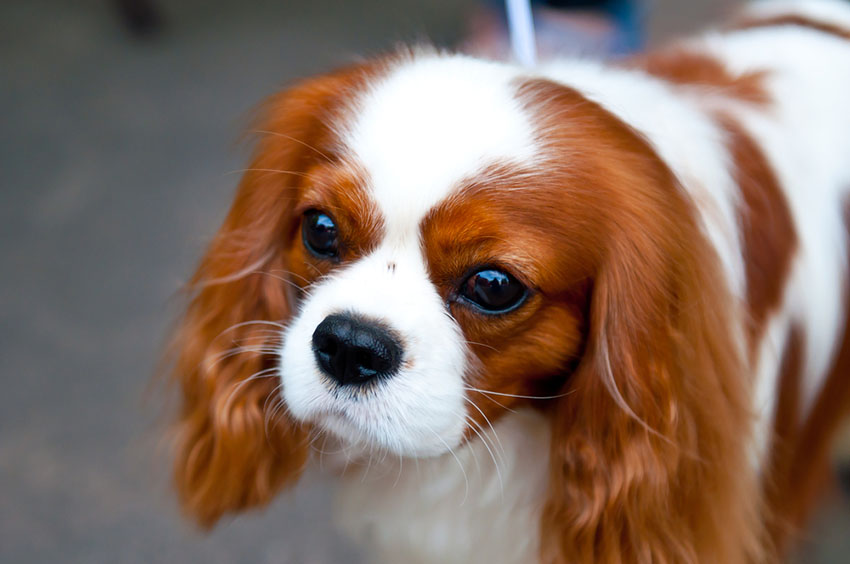Dogs tend to go in face-first, so their eyes sometimes bear the brunt of this inquisitive, act-first, ask-questions-later approach to life. From muddy puddles to thorn bushes, your dog’s eyes are vulnerable to damage.
Look at your dog’s eyes. Is anything different? They should be clear, bright and fully open. Hold up a treat for the dog to look at, so that you can take a good look at his eyes. Dogs, like humans, often have ‘sleep’ in the corner of their eyes, so don’t worry about that. However, if you notice anything unusual, contact your vet.

Sometimes a dog's long hair conceals his eyes, so check them out next time you're giving him a good fussing
Check for these problem signs:
- Redness on the whites
- Scratches
- Anything in the eye
- Any discharge or sign of infection (the discharge may be clear or cloudy)
- Cloudy eyes
- Inflammation in or around the eye
- Difficulty in seeing
- Increased sensitivity to light.
Eye infections can become very serious if they are neglected and can even cause permanent damage to your dog’s vision.

Look me in the eye and tell me you're healthy - all clear on the eye front for this thirsty Border collie
How To Treat an Eye Infection
Eye infections are usually treated with prescribed eye drops, to be administered once or twice a day, according to instructions.
Although this is rare, some dogs can be affected by an allergy such as hay fever. Your vet will judge whether this is the problem, and can prescribe saline solutions to wash the eye.

A Cavalier King Charles Spaniel with great big healthy eyes
Breeds Particularly Susceptible To Eye Problems
Breeds that are most susceptible to eye problems include Border Collie, Rough Collie, Shetland Sheepdog and Smooth Collie.
Breeds with short snouts or squashed faces – known as Brachycephalic breeds – are also susceptible to eye problems as their eyes protrude from their face and are not protected as they would be on non-Brachycephalic dogs.
These breeds include Cavalier King Charles Spaniel, Pug, Boston Terrier, Chow Chow, English Bulldog, Boxer, Shih Tzu, Pekingese, French Bulldog, Bullmastiff, and Staffordshire Bull Terrier.
There are hereditary eye problems that certain breeds are prone to, including Cataracts, ingrowing lashes (Distichiasis), and Ectropion, which causes the lower lid of the eye turns outward, making it look droopy. Breeds prone to the latter include Basset Hounds, Bloodhounds, and Saint Bernards. There is more information on these problems in the Hereditary Dog Defects section of this guide.

Brachycephalic breeds such as this Pug are susceptible to eye problems
Several breeds and mixed breeds have eyesight problems that are nothing to do with illness, and everything to do with bad hair days! Their hair simply grows so long that they can’t see anything. The Old English Sheepdog is a prime example of this. Keeping their fringes trimmed will solve the problem.
How To Clean Your Dog’s Eyes
Cleaning your dog’s eyes to remove unpleasant gunk – the dog version of the “sleep” that humans get in the corners of their eyes – is very easy. Simply use a piece of cotton wool and lukewarm, sterile water to gently mop it away.
This only applies to normal “gunk” though – if you notice any discharge, cloudiness, tears, encrusted fur around the eyes, or closed eyes, contact your vet. A dog’s eyes should be clear, bright and fully open. You must also check the lining of the dog’s eye sockets. Healthy ones will be pink, not white or red.
Avoid touching your dog’s eyeballs when washing any mess away.
How to Give Your Dog Eye Drops
Putting drops into your dog’s eyes is very simple, but if not done correctly it can quickly become stressful. Remain completely calm and confident throughout the process and then give your dog lots of praise and a treat once you have finished administering the drops.

A dog being given eye drops
3 Easy Steps to Giving Your Dog Eye Drops
It is helpful to wipe your dog’s eyes clean with sterile water before you begin. To make it easy for both yourself and your dog, kneel behind him and hold him firmly with your knees.
- Place one hand under his jaw and slowly tilt his head towards the ceiling.
- With the same hand, use your thumb to gently pull his bottom eyelid down to form a pocket.
- Squeeze the prescribed number of drops into this pocket and then allow him time to re-adjust before you administer the medication to the other eye.
Your vet might prescribe your dog with antibiotic eye drops if he has an eye infection and they might also prescribe steroid eye drops if your dog has conjunctivitis (more commonly known as red eye or pink eye). Some people also like to use saline eye wash to clean their dog’s eyes, but this is not helpful for an eye that is inflamed or sore.



Comments
There are no comments just yet